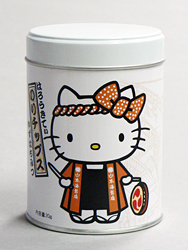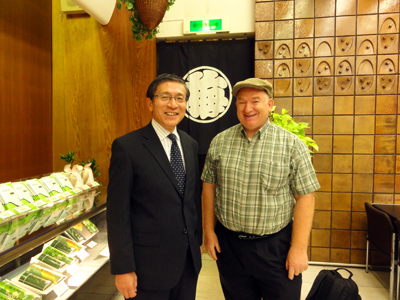 |
セインさん。今日、お伺いする老舗は日本橋の「山本海苔店」です。
Thayne-san, today the shop we’ll be visiting is Yamamoto Noriten. |
|
|
 |
三越の真ん前に本店があるのは知っているのですが、お店の中に入るのは初めてなんです。楽しみです。
I know the original shop is right in front of Mitsukoshi, but I haven’t ever been inside. I’m looking forward to it. |
|
|
|
 |
|
|
| (山本) |
ようこそ。セインさん、コンシェルジュさん。山本海苔店 副社長の山本泰人です。
Hi Thayne-san. I’m Taito Yamamoto of Yamamoto Noriten. |
|
|
 |
こんにちは、山本さん。立派なお店ですね。天井が高くて、気持ちがいいです。
It’s a pleasure to meet you, Yamamoto-san. Your shop is wonderful―the high ceiling makes it feel really airy. |
|
|
| (山本) |
ありがとうございます。当店は嘉永2年(1849)に、この場所で創業して以来、ずっとこの地で商売をしているんです。
今、東京の魚市場は築地にありますが、大正12年(1923)年に関東大震災が起きるまで、江戸―東京の魚市場はここ日本橋にあったんです。魚や貝や海藻が全国から集められ、競り落とされる・・初代は、そういう場所で店を開いたわけです。
Thank you. Ever since this shop was founded in 1849, we’ve been doing business in this location.
Tokyo’s fish market is in Tsukiji now, but until the Great Kanto earthquake in 1923, the Edo-Tokyo fish market was located right here in Nihonbashi. Fish, shellfish and seaweed from all over the country was brought here for auction. That’s why the first generation chose this spot for their business. |
|
|
 |
そうなんですか。
That makes sense. |
|
|
 |
セインさん、いまの日本橋は、歩いてみても魚市場があったことを想像するのが難しいんですが、鰹節の「にんべん」や佃煮の「鮒佐(ふなさ)」、蒲鉾・はんぺんの「神茂(かんも)」など、東都のれん会の加盟店で、ここに魚市場があったからこそ誕生したお店は、他にもありますよ。
As you walk along the street, it might be hard to imagine that this used to be a fish market, but there are other Toto Norenkai member shops who got their start here because of the fish market, including Ninben, Funasa and Kanmo. |
|
|
 |
そうでしたね!
ところで、海苔というのは江戸時代に生まれた食べ物なんですか?
Oh, that’s right!
Incidentally, was nori first made in the Edo Period? |
|
|
| (山本) |
いえ。702年に執行された『大宝律令』に、海苔が租税の対象として記載されていますし、8世紀初頭にまとめられた『風土記』という地誌にも海苔の記述が出てきますから、少なくとも1300年以上前には、海苔が食用を目的に採取されていたことがわかっています。
ただ、採った海苔を、和紙をすく要領で薄くのばして乾かした板海苔が発明されたのは江戸時代の江戸です。江戸前の海、いまの東京湾で海苔を養殖をして、板海苔に加工して、保存しやすく、食べやすくしたんですね。つまり、私たちがいつも食べている板海苔は、江戸生まれの食べものなんです。
Not at all. Nori is listed as a taxable good in the Code of Taiho, enacted in the year 702, and nori appears in Fudoki (ancient cultural and geographical records) collected at the beginning of the 8th century, so we know that nori has been harvested for at least 1,300 years.
But it was the city of Edo during the Edo Period that invented the process of spreading the nori thinly, no thicker than a piece of paper, and drying it. Nori was harvested from the sea near Edo, or present-day Tokyo Bay, and processed into sheets that were easy to preserve and eat. In other words, the nori that you and I eat all the time is a product of Edo. |
|
|
 |
現在も、東京湾で海苔を養殖しているんですか?
Is nori still harvested from Tokyo Bay? |
|
|
| (山本) |
東京湾でも海苔の養殖はしていますが、ごくごくわずか。生産量、品質ともに日本一なのは、有明海で採れる海苔です。そして、有明海で採れる海苔の選りすぐり中の選りすぐりが佐賀県で採れる「有明海一番」と呼ばれる海苔なのですが、ほぼ全量を、当社が買い取っているんです。
It is, but only a small amount. In terms of production and quality, the best nori comes from the Ariake Sea. And the cream of the crop is called “Ariake Ichiban,” from Saga Prefecture. We buy nearly all of the Ariake Ichiban harvested. |
|
|
 |
すごい! それはセリで一番高い値をつけて、最高のものをセリ落としているということでしょ?
Wow! I guess that means you always bid the highest at the auction and get the very best nori each time. |
|
|
| (山本) |
そうです。それが山本海苔店のステイタスにもなっているんです。
でも、肝心なのは、そうやってセリ落とした最高の海苔を買ってくださるお客様がいらっしゃるということなんです。
That’s right. Our reputation depends on it. But what really matters is that we have customers willing to pay for that quality. |
|
|
 |
少し高くても、山本海苔店の目利きを信じて買ってくださるお客様がいらっしゃる、と。
In other words, your customers trust the discerning eye of Yamamoto Noriten to choose the best product, even if it’s more expensive. |
|
|
| (山本) |
はい。ですから、商売というのは難しいんですよ。もちろん、それが楽しさでもあるんですが。
Yes, business can be challenging. Of course, that’s what makes it fun as well. |
|
|
  |
すごいお話ですね。
Very interesting. |
|
|
| (山本) |
海苔は、色、つや、形、風味などいろいろな基準で見極めるんですが、うちが重視しているのはやわらかさ、口どけです。 よく、真っ黒な海苔がいい海苔だと思っている方がいらっしゃいますが、黒い海苔はかたくて、いつまでも口に残るものが多いんです。海苔は、口に入れたら、すっと溶けるということが肝心なんです。溶けてこそ、口のなかに香りも、味も広がるでしょ。
Nori has many qualities that people look for, including color, shape, and aroma, but what we value most is whether the nori is tender and melts in your mouth. We often get customers who believe that dark nori is the best, but dark nori is less tender and tends to be harder to chew. Really good nori gently melts away in your mouth, giving off a pleasant taste and aroma. |
|
|
|
 |
|
|
 |
黒くて光沢がある海苔が上等そうに見えますが、そうじゃないのか。
Dark nori with a sheen looks like high-quality, but that’s not necessarily the case. |
|
|
 |
そういえば、真っ黒い海苔で巻いてあるおにぎりで、かぶりついても海苔が噛み切れないものがありますね。
Some onigiri rice balls are wrapped in dark nori, but it can be hard to tear with your teeth. |
|
|
| (山本) |
そうそう(笑)。色を基準に選んじゃだめですよ。
Yes, that’s right. You can’t select nori based on its color. |
|
|
 |
はい。
そういえば、セインさんは、アメリカにいた時から海苔をご存じでしたか。
Incidentally, did you know about nori when you were in America? |
|
|
 |
いえ。海苔を知ったのは、ほぼ30年前に日本に来てからです。
No, actually, I discovered nori when I came to Japan almost 30 years ago. |
|
|
 |
はい。
初めて食べたときの印象は?
What was your first impression? |
|
|
 |
うーん、最初はちょっとびっくりしたかも(笑)。
I think I was a bit surprised. |
|
|
 |
基本的に、海藻を食べる国は珍しいですし、そもそも黒い色をした食品というのが珍しいので、外国人は抵抗がある方が多いんですよね。
Basically, seaweed isn’t eaten in very many countries, and dark-colored foods are also rare, so it makes sense that there are a lot of non-Japanese who don’t care for it. |
|
|
 |
海苔は英語でlaver、seaweedといいますが、「weed」は雑草という意味ですから、あまりいい印象ではないんですよ。
In English nori is called laver or seaweed, and the word “weed” (“zasso” in Japanese) doesn’t give a very favorable impression. |
|
|
| (山本) |
外国の人たちに、もっと海苔を食べていただきたいんですが、難しいかなあ(笑)。
I would love for more non-Japanese to enjoy our nori, but that might not be so easy. |
|
|
 |
大丈夫。「健康にいいですよ」と言えば、アメリカ人は飛びつきますよ(笑)。
No problem, just say, “It’s healthy!” and Americans will come running. |
|
|
| (山本) |
そうか! 海苔はミネラルやビタミン、葉酸や食物繊維も豊富な健康食品ですから、もっとそれをアピールすべきなのかもしれませんね(笑)。 ちなみにセインさん、海苔は乳製品と相性がいいんですよ。食パンをトーストして、バターを塗って海苔をのせた「海苔トースト」はご存知ですか?
Ah! Nori is rich in vitamins and minerals, particularly folic acid and dietary fiber, so I guess we should be promoting those qualities more.
By the way, Thayne-san, nori goes well dairy products. Are you familiar with “nori toast?” You toast and butter a piece of bread, then eat it with nori on top. |
|
|
 |
海苔トーストですか!!
Nori toast? Sounds great! |
|
|
| (山本) |
ぜひ、試してみてください。朝食におすすめです。
それと、ちょっとこれを召し上がっていただけますか。新製品なんですが、 海苔入りチーズと海苔の佃煮をフリーズドライにしたスナック菓子なんです。
You should give it a try. I recommend it for breakfast.
Here, try this. It’s a new snack: nori with cheese, and nori boiled in soy sauce (called tsukudani flavored), and then it’s freeze-dried. |
|
|
|
 |
|
|
 |
チーズ味のこれ、おいしいですね。 佃煮味の方はビールに合いそうですね! 歴史のあるお店なので伝統的な商品ばかりかと思っていたら、こんな商品開発もしておられるんですね。
The cheese-flavored one is really good. The tsukudani flavor looks like it would be great with beer!
Since you have such a long history I thought maybe all your products would be traditional, but you’re also introducing new products like these. |
|
|
| (山本) |
ええ。30年くらい前から、ご飯のおかず以外にも海苔を食べてもらいたいということで、いろいろと商品開発をしてきているんです。その最大のヒット商品がのりチップスなんですが、ご存じですか?
That’s right. We want nori to be enjoyed in many ways, not just with rice, and for the last 30 years or so we’ve been developing a variety of new products. Our biggest hit so far has been nori chips. Have you had them before? |
|
|
 |
はい。梅味を食べたことがあります。
Yes, I’ve had the ume plum flavor. |
|
|
| (山本) |
のりチップスは、梅、玄米、ごまなどを海苔でサンドして、細長く切った商品なんですが、シンガポールでは「ゆずはちみつ」がよく売れているんです。ちょっと甘いんですが、海苔というのはこういうものだという先入観がないので、逆に抵抗なく買われるようです。
Nori chips are things like ume, barley, and sesame sandwiched between sheets of nori, and cut into long, thin pieces. Our yuzu-honey flavor is selling quite well in Singapore. It’s a little sweet, but in Singapore they don’t have any preconceptions of what nori should be, so people like it. |
|
|
|
 |
|
|
 |
なるほど。これもおいしい!ですね! キティちゃんの絵柄のシリーズもすっかりおなじみになりましたね。
Really. This is yummy, too! I’ve gotten really used to seeing this design with Hello Kitty. |
|
|
 |
今日、山本さんにお目にかかったら、ぜひ聞いてみたかった質問があるんです。うちの近くのお店もそうなんですが、お茶を売っている店が海苔を売っていることが多いのはなぜですか?
There was one question I really wanted to ask you today. Why do shops that sell tea also usually sell nori? The shop near my home sells both, for instance. |
|
|
| (山本) |
よくご存じですね。多分、海苔もお茶も乾物なので、取り扱い方が似ていてやりやすいということ。そして、初夏には新茶が出て商売が忙しく、それが落ち着いてくると今度は秋に海苔が採れ始めて、また忙しくなるということで、多忙な時期、お金が入ってくる時期が分散するのがいいんでしょうね。
You really know your tea shops. It’s probably because both nori and tea are dried goods and their handling is similar, so it’s easy to sell them together. New tea leaves are ready for market in the early summer, resulting in lots of business then, and by the time business slows down. nori is being harvested, and nori sales increase. So the shops have money coming in at different times of the year. |
|
|
 |
なるほど! それにしても海苔は秋から冬にかけておいしくなるんですね。
I see! But nori is especially tasty from autumn all the way through the winter. |
|
|
| (山本) |
はい。うちは「丸に梅」のマークなんですが、ちょうど梅のつぼみが膨らんでくる頃に海苔がおいしくなるんです。そして、梅も海苔も、香りを貴ぶものというところから、この商標にしたようです。
Yes. Our trademark is the Chinese character for plum inside a circle. Nori is delicious right at the time plum trees bloom. The trademark was chosen because for both the plum flower and nori, the aroma is valued above all. |
|
|
  |
わ~、あのマークには、江戸のお店らしいしゃれた理由があったんですね。 今日は楽しいお話をありがとうございました。
Wow, that’s the sort of sophisticated logic you’d expect from an Edo Period shop. Thanks so much for your time today. |
|
 |
|
(文)太田美代
(英訳)デイビッド・A・セイン |
 1959年、米国生まれ。証券会社勤務を経て来日し、翻訳・通訳など多岐にわたって活躍。豊富な教授経験を生かし、数多くの英語関係書籍を執筆。近著に『日本人のチョットへんな英語』(アスコム)、『超入門シャドーイング』(主婦の友社)、日本人が使いすぎる英語(PHP文庫)など多数。
1959年、米国生まれ。証券会社勤務を経て来日し、翻訳・通訳など多岐にわたって活躍。豊富な教授経験を生かし、数多くの英語関係書籍を執筆。近著に『日本人のチョットへんな英語』(アスコム)、『超入門シャドーイング』(主婦の友社)、日本人が使いすぎる英語(PHP文庫)など多数。











